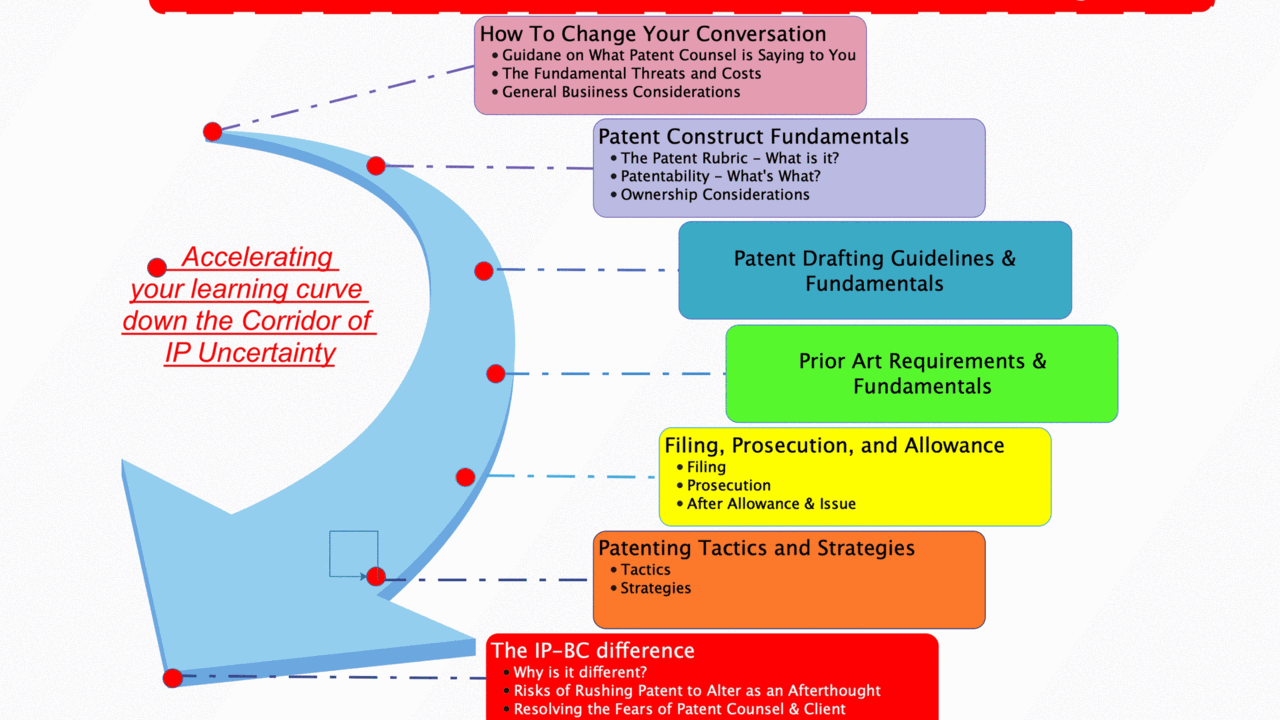IP SAVVYS Blog - select posts by role/title or by category
Schwartz's Story-for inventors only

"Innovators are reading my book as either a first step in their patenting gambit , as a pre-read for my course, or before using USTPO/PRESSMAN. The reason why is because it helps them "know what they don't know" about the complex domain of utility patenting, clarifying and refocusing their IP workflow. What’s unique about my book is that I simplify everything about patent drafting, turning it from an art to an engineering science. Specifically, I include an inside-out explanation of how to create utility-compliant patent using the Schwartz method, all in a one sitting non-legalese read, completely as seen from the innovator point of view,” says Schwartz.
Schwartz is not an attorney. As a serial inventor and entrepreneur he created and secured a storied patent portfolio on his original idea for a surface computer, all pro se. “I was a diligent consumer of all of the USPTO resources, as well as several editions of David Pressman’s book, thoroughly learning and applying his entire paten...
You know you're in the IP Zone as a team when...

You're in the IP Zone when all involved in forming the final invention disclosure understand the requirements for MPEP compliant filings. You’re in the IP Zone when the lead inventors are engaged in approving the final claims in the patent draft for the preferred embodiment, not just patent counsel. TSM’s universal language and guiding principles are your pathway to get everyone on the same page with these critical points of understanding.
When everyone on the team learns and applies the IP SAVVYS/TSM playbook for drafting airtight utility patents, you’re final application will have properly scoped claims aligned with an unambiguous specification…and the specification will be de-risked from fatal office action rejections. It will be definite, not ambiguous, and it will capture the essence of your "ah-ha" inventive step in the first claim.
Getting there is informed by a critical understanding of each team members patenting role and their respective goals and objectives. These can so...
10 steps every innovator needs to know about the pathway to patentship - MPEP at 1000 feet - read it in 1 sitting

Before you launch the sequence of steps patenting your novel, non-obvious, and “ah-ha” invention, the best way to start is by stating the obvious. The framework for utility patenting is surprisingly straight forward, but each of the steps is not only complex, they inextricably linked from one to the next…and once you start, the sequence is fraught with potholes.
In Part 1/Section2 of my Utility Patenting for IP SAVVYS book entitled “Getting the Patent: From trade secret to drafting, filing, prosecution, and allowance”, I cover the fundamentals of the steps in what I call "your pathway to patentship".
You will find it an easy read. It’s presented in "non-legalese", all from the inventor point of view. Read it here in one sitting because you owe it to yourself to fact-check your own understanding of your beliefs about what you will be doing during this pursuit.
-->>Part1/Section2 is included here at the bottom of this blog post. Scroll down to read the rest and find Section2 as the v...
Original Misconceptions: 2. Hand over an Invention Disclosure instead of a Schwartz Method Utility Compliant Disclosure (UCD)

When engaging outside counsel to assist you in the process of preparing and filing a patent, you will always be asked to submit an invention disclosure document as part of the work flow. Often, you will be asked for this "early" as possible in the counsel's project plan since this is the basis for the drafting of a preliminary patent application. The invention disclosure will elicit an array of content components starting with the title of your invention, the inventors, the background and field of art, and so forth. It all seems perfectly logical...how can you ask counsel to work on a patent draft if you don't give them "the goods".
That said, it is a common misconception that you MUST give them the invention disclosure EARLY. In fact, if you have a proper internal utility patenting workflow, not only will you be keeping your invention as a trade secret until the time you choose, but you will also be developing an internal form of invention disclosure as part of your product develop...
De-risking patents from FOARs/Get SCA & make them AIRTIGHT

This series of blog posts seeks to set the record straight on the goal of getting Utility Patents to publish with SCA (Sustainable Competitive Advantage).
In our definition, a patent that publishes with a CLEAN FILE-WRAPPER (no FATAL flaw do-over's) and with CLAIMS that broadly scope the PREFERRED-EMBODIMENT (P-E), will turn out to be patents with SCA.
Why? First, their chain of ownership will be identified with a published patent that has the right look and feel. Second, when ANYONE looks at the File Wrapper ( a public document from the Patent Office), they won't surface any chinks in the armor out of the "starting block". Thirdly, when they look at the object of their invention and what THEY want to go to market with, it will READ on the primary claims in the published patent ( and give them a moment of pause), and in this pause THEY WILL RECONSIDER whether to attempt to file a post publication action in an attempt to invalidate your patent.
Good enough. The simple IP model for Ut...
Flash Of Genius (FOG) ... with respect to ENABLEMENT

"Land-Ho" . . . inventing is a little like sighting land after navigating with no land in sight and nothing but fog on the horizon...
Trying to explain inventing to another is a real challenge, and the exhilaration of discovering "it" can't be easily captured. "Land Ho" is my close approximation for now. All of a sudden, in a flash you know the invention... there's land. The Vikings sensed when they were near shore and would light the tips of their arrows, shoot them into the fog off the bow, and wait until one landed and the flames caught.
So Who Cares about the FLASH-OF-GENIUS, why did it really matter Before AIA(BAIA), and what is it's value After AIA (AAIA)?
This blog category seeks to explore this fundamental principle of inventing, the "AH-HA" moment, in the context of what it means to be First-To-File. Keep in mind that the rule book for any of this is the Manual of Patent Examination Procedures (MPEP). The requirements for a non-provisional utility patent application tha...
Since we're First-To-File, my invention notebook and my date of conception don't matter now

Wrong :) You know that they still matter since your invention notebook is your iterative innovation tool. Yes, at one time, when we were First-To-Invent (FTI), it's role documenting your initial conception, played a more critical role in establishing patent priority and monopoly rights. Even with the new AIA First-To-File (FTF), date of conception can still play a role in certain circumstances, especially during infringement battles that might result in an injunction or the payment of forced royalties. But that's not my point here. The importance of Schwartz's Big-Bang-Theory of IP Capitalization and the factoring of The Schwartz Method (TSM) into Product Lifecycle Management (PLM) has a more fundamental role.
Achieving FTF on a true Preferred-Embodiment (P-E) is a matter of integrating patent preparation into every nook and cranny of the product development road map. The days when the luxury of filing unfocused provisionals and drafting the patent on the P-E as an afterthought, are ...

